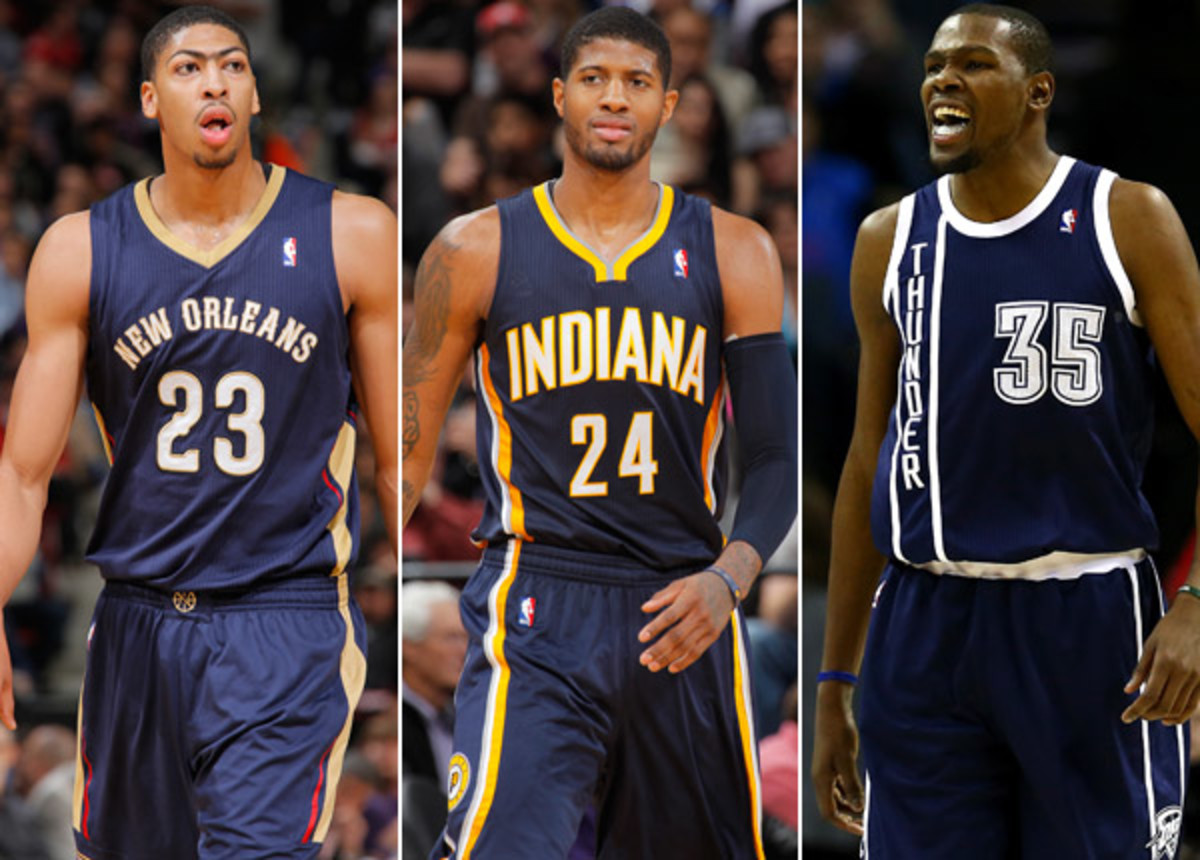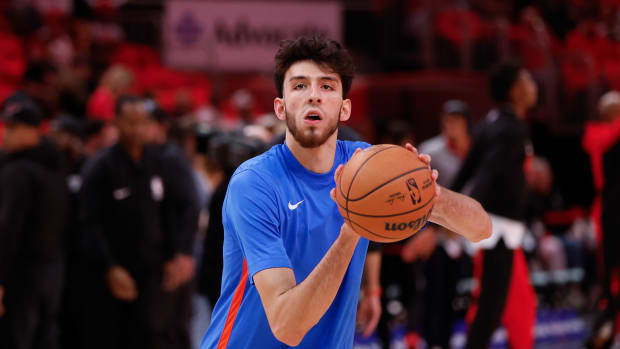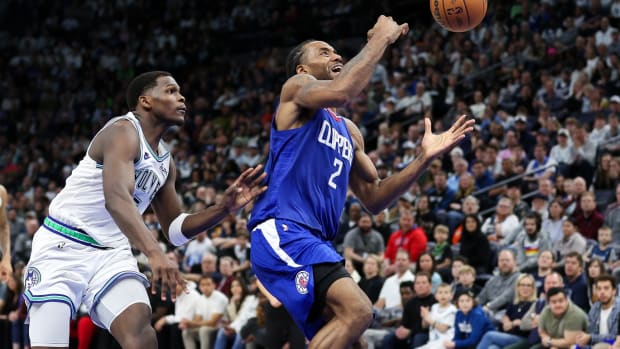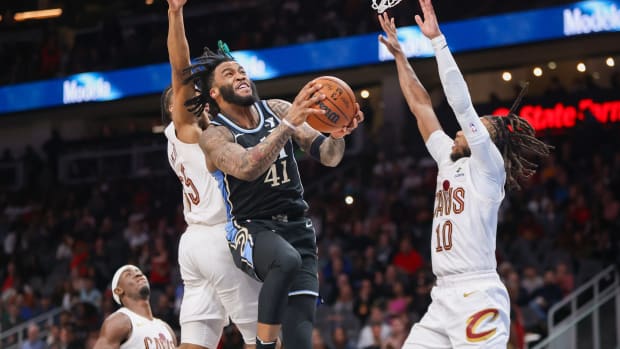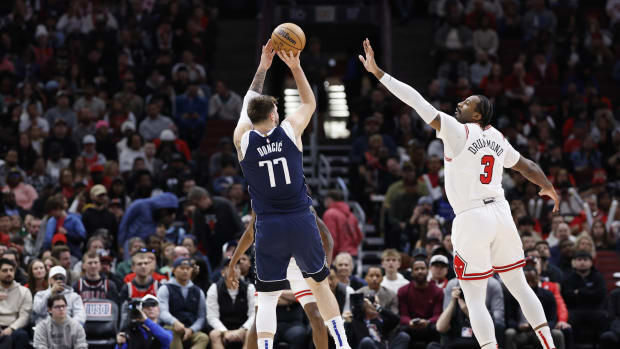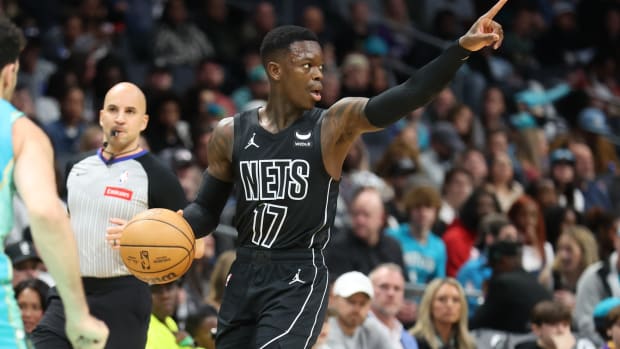The Fundamentals: The many layers and many candidates for Most Improved Player
Several big names are in the running for 2013-14 Most Improved Player award. (Getty Images)
Of all the NBA's accolades, the Most Improved Player award is easily the most ridiculous.
It is the only piece of pro basketball hardware based on underachievement. For a player to qualify, voters essentially have to deem his previous offerings unremarkable. Only then can a player make his case for award-worthy improvement, which in many cases is simply the routine development of a young player finding his way in the league or an overdue increase in playing time for a quality prospect.
The award itself is a blank slate on which the voter can project whatever criterion he or she deems appropriate. The NBA has actually made vague attempts to clarify the award's intent ("to honor an up-and-coming player who has made a dramatic improvement from the previous season or seasons,") largely as a means of differentiating it from the now-defunct Comeback Player of the Year Award. Still, some voters look strictly at increases in production without regard for corresponding bumps in playing time. Certain voters prefer rewarding the jump to stardom. Others favor the complete shocker -- the unanticipated leap from fringe NBA type to valued role player.
All of the major NBA awards draw on some measure of subjective interpretation -- it's implicit in the spirit of the awards themselves and an established part of award discussion. But none of the NBA's other major honors is so wide in its possibilities that it allows voters to define its bounds almost entirely for themselves. "Most improved" is a term so malleable that it serves any purpose or agenda, amorphous to the point of near meaninglessness.
And yet it continues to exist, and thus in some capacity continues to matter. Come April, some player will be given this suitably senseless trophy -- a crystal bookend finished with a bland sketch of two basketball players (symbolism!) and font-bordering-on-WordArt -- and be remembered for it. For that reason alone this silly prize is worthy of our thorough consideration, as the Most Improved mantlepiece carries with it a regrettable import. With no way around the internal divisions of this award, though, there seems little choice but to accept it in its fractured entirety. Below are the most common archetypes of the most improved, so that at the very least we can identify the most suitable candidates by each choice criterion.
The Organic Rise
Prototypes: Gilbert Arenas (2003), Zach Randolph ('04), Monta Ellis ('07)
Current candidate:Anthony Davis
This might be the most annoying of MIP sub-genres -- the awarding of a young player merely taking the next step in his NBA path. Don't get me wrong: There's plenty to celebrate in that growth alone. But handing out hardware for prospects establishing themselves in the league seems at best frivolous.
Still, this kind of voting is prevalent enough that it needs to be addressed, albeit without much debate. Davis is the easy, pronounced pick. He's mounting an incredible season for the Pelicans, doing it all in a way that makes hoops heads giddy about his developmental arc. Davis, 20, still has a long way to go in terms of stabilizing his defensive influence, but one can already find exceptional skill and awareness in the way he blows up pick-and-rolls with regularity, extends to challenge attempts that would be beyond most other shot blockers and glides along the floor with increasingly efficient movement.
GOLLIVER: Midseason grades for all 30 NBA teams
That he's also become a far more prolific scorer without being able to lean on any of New Orleans' primary ball handlers only accentuates his case. Jrue Holiday has been injured, Eric Gordon erratic and Tyreke Evans a bit errant. But Davis finds his way to the bucket by his own devices, and he's brimming with potential on both ends of the floor. He's also a former No. 1 pick coming off a season of injury, which makes tabbing him for this award feel like giving a blue ribbon for meeting expectations.
Other candidates who fit this criterion: John Wall, DeMarcus Cousins, John Henson, Markieff Morris, Terrences Jones, Jeremy Lamb.
The Big Surprise
Prototypes:Boris Diaw ('06)
Current candidate:Kendall Marshall
On occasion, a buried player will catch the league by surprise, allowing for one of the more optimal interpretations of the Most Improved Player award. There's inevitably an element of circumstance involved (Diaw, for example, would likely not have been unleashed were it not for both Mike D'Antoni's open-mindedness and Amar'e Stoudemire's injury in 2005) in such cases, but the candidates are so wholly unexpected and their on-court growth so stark that there's little disputing their improvement.
A few players could qualify under that umbrella this season, but the Lakers' Marshall makes the strongest case. The reclaimed point guard ranks second in the league in assists per game (9.3) and three-point percentage (47.9). The former is an understandable -- if exaggerated -- representation of Marshall's scouted strength, but the latter is indicative of jaw-dropping change. Before Marshall signed with Los Angeles, perimeter shooting (or lack thereof) was a big part of why he was out of the league. It's increasingly difficult to use point guards who are neither threats to drive nor threats to shoot, a combination that led the Suns (who drafted him 13th in 2012) and Wizards to give up on Marshall in short order. He's still not much of a threat to get all the way to the rim consistently without ample screening help, but Marshall has shored up his shooting to the point of securing NBA employ for the foreseeable future.
THOMSEN: Midseason Report: Reviewing the NBA's first half
Other candidates who fit this criterion: James Johnson, Michael Beasley, Trevor Ariza, Xavier Henry, Boris Diaw (again!).
The Systemic Fit
Prototypes:Hedo Turkoglu ('08)
Current candidate:Gerald Green
Sometimes "improvement" is as simple as finding the right place to ply your trade. Green, 28, wasn't as useless an offensive player as he seemed last season in Indiana, where he shot his way out of a job by hitting on just 36.6 percent of his attempts. But he's also caught on in Phoenix largely because his role aligns rather perfectly with his talents. Suns coach Jeff Hornacek doesn't ask Green to do anything that he can't do well, and as a result the well-traveled swingman has given valuable minutes and production to a team in position to benefit from his game.
THOMSEN: All-Star starters, snubs, improvements and more mailbag questions
Phoenix's transition bent suits Green well, but so does a controlled role as a shot creator alongside Goran Dragic. In all, that's made for a nice bounce-back season, even if Green's improvement is as contingent on situational factors as any personal advancement.
Other candidates who fit this criterion: Miles Plumlee, Robin Lopez, Monta Ellis, Marco Belinelli.
The Role Adjustment
Prototypes: Paul George ('13)
Current candidate:Lance Stephenson
Stephenson's case for the award is the most public and the least in need of explanation. It should go without saying that it behooves a talented, versatile player to have greater opportunity to make different kinds of plays, though Stephenson has taken to his jack-of-all-trades role for Indiana with exceptional potency and gusto. Simply reaching the point of shouldering that responsibility qualifies as an improvement for the 23-year-old guard in his fourth season; not a year ago the thought of Stephenson running a second-unit offense was a bit concerning, whereas now his playmaking has helped reinforce the strengths of all kinds of lineups. His game grew up, and the Pacers were in a perfect position to continue expanding Stephenson's role as that growth warranted.
Other candidates who fit this criterion: Reggie Jackson, Mike Conley, DeMar DeRozan.
The Minutes Swell
Prototypes:Aaron Brooks ('10), Kevin Love ('11), Ryan Anderson ('12)
Current candidate:Isaiah Thomas
A handful of MIP winners were good players before winning the award and good players after, separated largely by their coach's willingness to play them more consistent minutes. If you're a sucker for rewarding bumps in playing time for players who were essentially good enough to be logging bigger minutes in the first place (ugh), then the Kings' Thomas is a prime choice.
GOLLIVER: All-Gridiron: NBA players who would dominate in NFL
This isn't to say that the 24-year-old point guard hasn't improved over the past year. He's already taken a step forward as a playmaker, nudging his shoot-pass balance closer toward equilibrium. One could make a claim for his candidacy on those grounds, enhanced by his steady shooting in a larger role. But some will inevitably be drawn in by Thomas' uptick in production, ignoring the fact that he put up big per-minute numbers last season (18.7 points and 5.4 assists per 36 minutes) while logging less time than he likely deserved. Better though he might be relative to last season, Thomas' per-game spring overstates his improvement a bit.
Other candidates who fit this criterion: Eric Bledsoe, DeAndre Jordan, Timofey Mozgov.
The Scoring Jump
Prototypes:Danny Granger ('09)
Current candidate: Goran Dragic
Among the blander ways to crown a Most Improved Player is to layer one year's numbers over the other, looking solely at which players have made the biggest jump in production. With scoring being the most obvious (and to some, the most important) of statistical contributions, it's no surprise that many MIP winners boast big jumps in scoring average regardless of contextual factors.
ROUNDTABLE: Midseason awards: MVP, Rookie of the Year and more
The aforementioned changes in role, system or minutes are in some cases responsible, though there are those players who manage to ramp up their output without seeing their situation change much. Among the players in the midst of such an improvement this season, Dragic is the most compelling.
Dragic is playing all of 1.3 minutes more than he did for Phoenix last season, and if anything has seen his workload lessened by playing alongside Eric Bledsoe. Yet his scoring is up (from 15.8 points per 36 minutes to 20.1), his shooting efficiency has risen (54.3 effective field goal percentage, up from 49.1), and his turnovers have dipped (16.8 turnover rate to 14.4). All of those marks are career bests for a 27-year-old guard filling the same role for the same team, though it's worth noting that the arrival of Bledsoe and hiring of Hornacek have had a bit to do with Dragic's terrific season. Still, his improvement is his own -- he's more confident and competent than ever, and as sound a choice as you'll find by this MIP definition.
Other candidates who fit this criterion: Arron Afflalo, Wesley Matthews.
The Great Leap Forward
Prototypes: None
Current candidates: Paul George, Kevin Durant
This is in no way an established archetype, but it damn well should be. Improving through a bigger role, a better fit or more consistent minutes is in no way comparable to the uphill grind necessary for the great to become greater. Take George, last year's Most Improved, for example. As of a season ago, George was an excellent defender doing fine, far-reaching work in a bigger offensive role than ever. Still, he was no superstar; George was overstretched to the point of being turnover-prone and lacked the ability to create good, makeable shots to the point of supporting an efficient NBA offense. He was still effective enough on both ends of the floor to be deservedly named an All-Star reserve, but George was several tiers removed from the true elite.
DOLLINGER: Thunder reach No. 1 in latest NBA Power Rankings
In less than a year he's cleared that gap, ascending to a spot as a top-10, if not top-five, player. But because George is now well-established and because he won the award last season, he'll go omitted from most ballots. That's more than a bit odd. George now faces more committed and severe defensive pressure than ever and yet he has responded with personal highs in scoring and shooting percentages and a personal low in turnover rate. He's one of few players asked to both act as a primary creator and defend an opponent's best scorer on an every-play basis (something from which even LeBron James and Durant are spared), and rather than buckle under the weight of that responsibility, he's surged forward. This isn't just an improvement in scoring, shooting efficiency and ball control, but a sudden ascent against an impossible slope.
Durant is in an even more fascinating position. On the most superficial level, it might seem as if there isn't much room for Durant to grow -- that the most he could do would be to unseat James, moving from the consensus second-best player on the planet into the top slot. But can we consider for a moment just how insanely difficult that is? How challenging it is to jump to a league-leading usage rate while bolstering his shooting efficiency in the process? To contribute more assists and commit fewer turnovers while acting as a predominant creator? And to do so all while operating without Russell Westbrook, the underlying engine of the Thunder offense?
When weighing one player's improvement against another, that declination should matter. Not every point or rebound or percentage gained is equivalent; it's far more difficult for some than others, particularly once the player in question has already reached conventional levels of stardom. That's the lot that George and Durant are working with, and yet both bound up the NBA ranks as if they weren't so burdened.
NEXT PAGE: Kevin Durant on the attack, Draymond Green getting his hands dirty, and the driving struggles of Damian Lillard.
GO FIGURE
Anything more than a layup is a risky proposition for Tyreke Evans. (Layne Murdoch/NBAE/Getty Images)
• When New Orleans residents see Tyreke Evans loading up a jumper, I'd advise them to duck and cover. His shot chart is a bloody mess, but no measure of Evans' shooting is more harrowing than this: Outside of the restricted area, he's shooting just 23.6 percent.
• It's been an odd year for Kevin Garnett, the worst of his career in many respects. But diminished playing time (he averages just 22 minutes per game) has helped obscure the fact that Garnett has actually done a pretty marvelous job on the glass -- a necessity for a team playing without Brook Lopez and that recently has turned to lineups without a traditional power forward. Brooklyn needs Garnett to be a rebounding force, and in limited minutes he's delivered: The 37-year-old has secured a startling 31.5 percent of available defensive rebounds, the best mark in the NBA.
That he averages a mere 6.9 rebounds per game helps hide that superlative rebounding in plain sight, but when on the floor Garnett has quietly been one of the most prolific rebounders in the NBA this season. You can tell everybody. Yeah, you can tell everybody. Go ahead and tell everybody. He's the man, he's the man, he's the man.
• Damian Lillard is more shooter than finisher, but that doesn't totally explain why the Blazers' lead guard -- who ranks in the top 20 in drives per game, according to SportVU -- shoots just 33 percent on his drives. For contrast, the stylistically similar Stephen Curry completes 47.9 percent of his field goal attempts on drives. Thirty-three percent, on the other hand, is well into Brandon Jennings/Dion Waiters territory. Considering that Lillard is clever, skilled and athletic, what gives?
NOTES FROM AROUND THE ASSOCIATION
1. Jared Dudley's rebounding is dust in the wind
It's kind of frightening how quickly and quietly Dudley's ability to rebound has evaporated. Early in his career, Dudley was a bit of a hustle junkie for the Bobcats and Suns -- so much so that he grabbed an impressive 11.3 percent of available rebounds during his first two seasons. That kind of mark would put Dudley in the mix with the likes of Durant and James as a wing rebounder this season. Instead, Dudley's rebounding has caved as a Clipper. His 4.4 rebounding percentage isn't just a rough third of what it used to be, but one of the lowest marks among NBA rotation regulars.
There are all kinds of mitigating factors (two of which start in the Clippers' frontcourt) involved, and under the right circumstances maybe Dudley would be a more active rebounder once again. But as it stands now, it doesn't exactly help Dudley's up-and-down shooting that one of his supplementary contributions has vanished.
2. The opportunistic Kevin Durant
That moment in semi-transition when Durant realizes he might be able to get to the basket without being quadruple-teamed ... only to actually get quadruple-teamed and score anyway:
3. The first step is admitting that we have a problem
These bench nicknames are getting a little out of hand. While I can appreciate that some groups of reserves have come up with their own monikers organically, we've now gotten to where media members prodded the Magic's bench players about a potential nickname to the point that they conjured up a fittingly generic one. Please, I beg you: Let nicknames happen, but don't force them.
4. Draymond Green: Above the law
Watch the Warriors' Green in this clip as he sets an initial pin-down screen for Klay Thompson, with "help" from Serge Ibaka:
Green, it seems, is learning basketball's dark arts. Wherever could he have picked that up?
5. The shortest distance between an improvisational ball handler and a highlight finish
Chris Paul's absence has unexpectedly coincided with a run of fun basketball for the Clippers, offering room to highlight some elements typically dwarfed by Paul's influence. Allow me to indulge in one of the more trivial ingredients: Jamal Crawford's increasingly prevalent lobs.






























